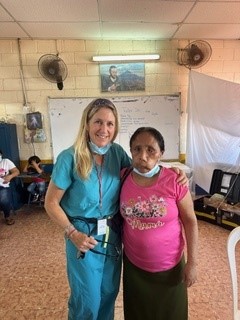Janie Baker, MD: Overlook Family Medicine
Guatemala: October 2024

Our team consisted of 25 volunteers from the United States and Canada, dozens of community volunteers, and Guatemalan Faith in Practice staff. As is typical for a village team such as ours, we occupied a local elementary school for the week where we cared for over 1000 patients. As we were near the Caribbean, the climate was very hot and humid, making for long and challenging days.
We arrived in Puerto Barrios, Izabal, Guatemala, a new community for Faith in Practice. Our team was the first team to serve the people in this eastern department, sandwiched between Belize, Honduras, and the rest of Guatemala. It is also home to the Garifuna people, who are descendants of Carib, Arawak, and West African people. They landed on the island of St. Vincent as the result of a Spanish slave shipwreck in the 1600s. Eventually they fled to the Caribbean coasts of Guatemala, Belize, Nicaragua and Honduras. They have their own language, Garifuna, with influences from Spanish, English, French, African and Dutch languages.
We also cared for Mayan people. This group took 2 boats to get to our clinic in Puerto Barrios, one from their town along the Rio Dulce to Livingston, and a second in the ocean to us. It is extraordinarily humbling to care for these patients who travels so far to have a few moments of our time and care.
We care for many individuals desperately in need of resources. One of the most memorable patients I saw was a former musician who suffered from severe malnutrition. He was down to 80 lbs due to severe food insecurity. Unfortunately, Guatemala does not have resources such as food banks that we are fortunate to have in our country. It broke my heart. I was struck by how much food insecurity I encountered during this mission.
We were able to refer over 200 of our patients for life changing surgeries such as hernia repair, gallbladder surgery. and joint replacement. We also have a mobility clinic, donating wheelchairs and other mobility assistance to patients in need. One of the most gratifying sights was seeing the face of a young boy who was born with severe leg deformities who was ecstatically wheeling himself all over the courtyard in his new wheelchair. One of the simplest yet most helpful things we provide are reading glasses. Imagine being a seamstress or a writer or a cobbler and not being able to see up close after the age of 40? The glasses are life-changing in that they allow people to continue working.
Finally, I was so happy to be able to spend time with Coco, my first interpreter, and his family during my last day in Guatemala. I’m very proud that he is now completing his 6th year in medical school, and after next year plans to begin his residency in anesthesia.